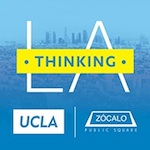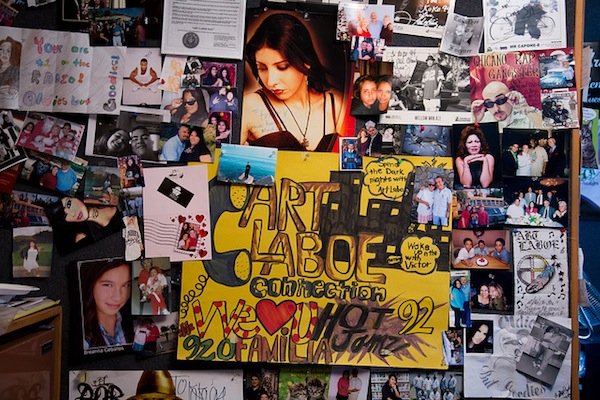ââåwithout Art Laboe Iã¢ââ¢m So Lonely I Could Cryã¢ââ Adam Vine
The boondocks I alive in is alone. Then alone I could weep. And then goes the refrain from one of Thee Midniters' hits, and such is the feeling in my heart now that DJ Art Laboe has been taken off the air in Los Angeles considering his station changed formats. HOT 92.three, which played old-school R&B, has get REAL 92.3, "LA'due south Hip-Hop N' R&B" station. If yous don't know, 89-year-old Laboe is the one of the terminal pieces of living history connecting L.A. to the origins of rock and roll radio—a lineage that includes Wolfman Jack, Alan Freed, and Dick Clark.

Art Laboe had been hosting "request and dedication" radio shows for more than than 60 years when I offset fell for him in 2006. As a night P.A. for a Boob tube network sitcom, I delivered scripts effectually the midnight metropolis for the producers, writers, actors, and executives to find on their doorsteps the following morning. Laboe'due south playlists eased my journeys through the hazy maze of freeways. Listening to him, I learned the intersections of Fifty.A.—its geography and musical history. His signature blend of smooth old-school R&B conjured a nostalgia in me for the nascency of West Coast rock and scroll in post-state of war Los Angeles, an era long before my time.
In the 1950s, Art Laboe had his first striking radio testify with a Fri night live circulate from Scrivener'due south Drive-In Restaurant in Hollywood at the corner of Dusk and Cahuenga. In that American Graffiti-esque setting, Laboe took requests from teenagers in their cars. Fifty years later on, I'd pass this corner virtually nights when I was finishing my deliveries. Scrivener's had get a Jack in the Box. So it goes.
Without Fine art Laboe on the air, nosotros accept lost more than a radio testify; we've lost a lifeline.
When Laboe began to host concerts in 1955, he did so outside L.A. city limits to adjust his multiracial teenaged audience. Rock and roll had grown popular with white youth, and LAPD Chief William H. Parker and the Fifty.A. City Quango cracked down on integrated dances, so promoters like Laboe looked elsewhere in the county. Thus began Laboe's human relationship with El Monte, which allowed teenagers to trip the light fantastic toe freely together, and the El Monte Legion Stadium. Laboe's audition packed the stadium every other week to leap to the sounds of R&B and to slow dance to the Penguins' "Earth Angel." The concert series, and the lowrider culture that grew around information technology, sealed the devotion of Art Laboe's working-class Chicano fan base of operations.
In a footnote to that history, Laboe released a single by the Penguins in 1963, "Memories of El Monte," that was co-written by Angeleno and doo-wop fanatic Frank Zappa. The song refers to those early concerts:
Remember the trip the light fantastic I held you then tight,
The Satins were singing "In the nevertheless of the Night."
You gave me your middle and your love undying,
At present I'm alone, I'thou sitting here crying.
Memories of El Monte are all that remain. The stadium was torn down in 1974, and now information technology'south a mail service office parking lot. So it goes.
Around the time of the Zappa song's release, Laboe coined the term "Oldies but Goodies" (he owns the trademark) and he's been playing them ever since. But his Oldies but Goodies are not the songs of Oldies stations everywhere. You're not likely to hear the Beatles or the Stones; rather, Laboe'southward repertoire consists primarily of Chicano Soul, which blends doo-wop, R&B, and soul. Every jam is a wearisome jam.
Art Laboe endured because he besides adapted to include newer artists that fit this feeling into his playlists, similar Sheila E., Boyz II Men, En Vogue, and Babyface. But Laboe stood out because he mixed hits from well-known artists similar Smokey Robinson and Etta Baker with deep cuts from more obscure ones—Brenton Forest, Barbara Lynn, and Thee Midniters.
No ring typifies Fine art Laboe's work more than than Thee Midniters, an all-Chicano band from East Los Angeles. They evolved from playing Wilson Pickett covers and rave ups well-nigh Whittier Boulevard to political anthems ("Chicano Power") and scorching soul ballads like "The Town I Live In" and "Making Ends Meet." Their atomic number 82 vocaliser, Little Willie Chiliad, still appears at Laboe'due south concerts (yes, Art Laboe is still hosting concerts—as recently equally Valentine'south Day) and tin can as well be heard on Ry Cooder'southward concept album Chávez Ravine.
One of the tragedies of Fine art Laboe's departure from the L.A. airwaves is that we tin't hear bands like Thee Midniters anywhere else on the radio here. But the deepest loss is the dedications themselves. In contrast to Delilah, the reigning queen of the request and dedication prove, who dispenses advice to her lovelorn callers, Art Laboe lets the songs give the advice. He serves merely every bit a messenger of dedications with a classic radio voice. He also records and plays listeners' dedications in their own voices. As such, his testify functions like a Post Secret for his audition: the dedications are total of apologies, nicknames from the neighborhood, and bilingual declarations of love in all its forms: familial honey, honey lost, love re-found, and, about crucially, love maintained in the confront of separation.
Fine art Laboe's highest achievement is that he connects people separated past altitude and time, which is particularly helpful for people with incarcerated family members. His prove has been a longtime favorite among prisoners in the California Department of Corrections and Rehabilitation, and callers often dropped hints: Every time I heard, "Nosotros got your letter," or a dedication went out to someone "up in Chino," I assumed its intended recipient was locked up there. Without Fine art Laboe on the air, we have lost more than than a radio prove; we've lost a lifeline.
The other night I listened to Art Laboe's show online, and a dedication came on, along with a request for "The Agony and the Ecstasy" by Smokey Robinson. I heard a woman pledge to her hubby: "I'll always exist here for you, you don't fifty-fifty have to worry about information technology."
I tin't say whether her married man is serving fourth dimension, serving in Afghanistan, or driving a long-booty truck, but it was clear from her tone that he's far away and not coming back soon. How frequently are nosotros able to bear witness to enduring love? How often do we encounter, or hear, such intimacy?
Hence the proper noun of his show: The Art Laboe Connection. Laboe connected united states of america to our metropolis's history, and he continued us to couples experiencing the aforementioned desperation and ecstasy felt in every household at some point.

The other secret of Fine art Laboe is that he notwithstanding resonates with young people but like he did at Scrivener's Drive-In. Almost of the outrage I've seen since his station inverse formats has come up from some young community organizers and artists I know. These sophisticated music fans are equally likely to exist listening to Kendrick Lamar, Immortal Technique, or Radiohead, simply they were raised on Art Laboe, and they constitute his prove to be as healing and moving as I did.
I still reach for the HOT 92.3 radio preset when I'thou driving home at nighttime. But Art's not at that place, and evenings in Los Angeles are decidedly less romantic.
The but consolation is that yous can hear his show well-nigh nights of the week on the outskirts of Los Angeles—in Oxnard, San Diego, Barstow, and Bakersfield. He'due south likewise still on in Tucson and Las Vegas, and you can listen online at Fresno's KOKO94.com. While I'm hopeful that Laboe will find a new home in Los Angeles, I capeesh the irony of missing his music. I'm in dear with something, someone, who's far away. The boondocks I live in is lonely. Then lonely I could weep.
Source: https://www.zocalopublicsquare.org/2015/03/02/without-art-laboe-im-so-lonely-i-could-cry/ideas/nexus/